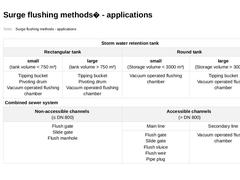
|
(Table: Surge flushing methods - applications) |
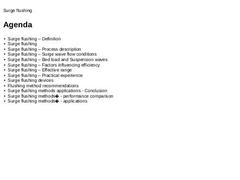
|
|
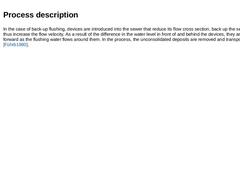
|
In the case of back-up flushing, devices are introduced into the sewer that reduce its flow cross section, back up the sewage and thus increase the flow velocity. As a result of the difference in the water level in front of and behind the devices, they are driven forward as the flushing water flows around them. In the process, the unconsolidated deposits are removed and transported [Führb1980]. |
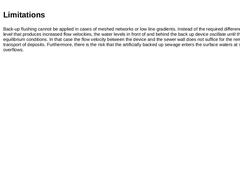
|
Back-up flushing cannot be applied in cases of meshed networks or low line gradients. Instead of the required difference in the water level that produces increased flow velocities, the water levels in front of and behind the back up device oscillate until they reach equilibrium conditions. In that case the flow velocity between the device and the sewer wall does not suffice for the removal and transport of deposits. Furthermore, there is the risk … |
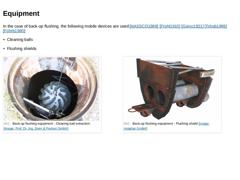
|
In the case of back-up flushing, the following mobile devices are used [NASSCO1989] [Frühl1910] [Gürsc1921] [Tchob1989] [Führb1980]: -
Cleaning balls
-
Flushing shields
(Image: Back-up flushing Cleaning balls – Process description) (Image: Back-up flushing equipment - Flushing shield) |

|
This method comprises the transport of spherical devices with structured surfaces through drainage channels for the sole purpose of deposit removal [DIN EN 14654-1]. (Image: Cleaning balls in different sizes) |
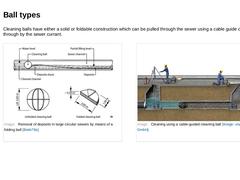
|
Cleaning balls have either a solid or foldable construction which can be pulled through the sewer using a cable guide or pushed through by the sewer currant. (Image: Removal of deposits in large circular sewers by means of a folding ball [Biele1979]) (Image: Cleaning using a cable-guided cleaning ball) |
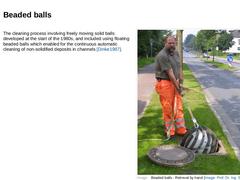
|
The cleaning process involving freely moving solid balls developed at the start of the 1980s, and included using floating beaded balls which enabled for the continuous automatic cleaning of non-solidified deposits in channels [Dinke1987]. (Image: Beaded balls - Retreval by hand) |
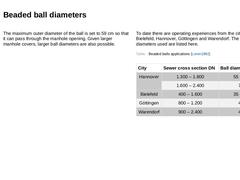
|
The maximum outer diameter of the ball is set to 59 cm so that it can pass through the manhole opening. Given larger manhole covers, larger ball diameters are also possible. To date there are operating experiences from the cities of Bielefeld, Hannover, Göttingen and Warendorf. The ball diameters used are listed here. (Table: Beaded balls applications) |

|
(Video: Depiction of principle of cleaning with beaded cleaning balls) Video: Cleaning process with the automatic insertion and extraction of beaded balls [Dinke87] [Image: visaplan GmbH]. This interactive object is only visible online. |
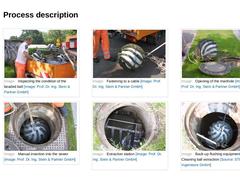
|
| (Image: Back-up flushing Cleaning balls – Process description) | (Image: Back-up flushing Cleaning balls – Process description) | (Image: Back-up flushing Cleaning balls – Process description) | | (Image: Back-up flushing Cleaning balls – Process description) | (Image: Back-up flushing Cleaning balls – Process description) | (Image: Back-up flushing Cleaning balls – Process description) |
|

|
|
(Image: Back-up flushing Cleaning balls – Recovery station) |
(Image: Back-up flushing Cleaning balls – Recovery station) |
|
(Image: Back-up flushing Cleaning balls – Process description) |
(Image: Back-up flushing – Recovery of the cleaning ball) |
|
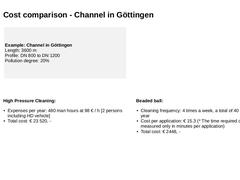
|
Example: Channel in Göttingen
Length: 3600 m
Profile: DN 800 to DN 1200
Pollution degree: 20% |
High Pressure Cleaning: - Expenses per year: 480 man hours at 98 € / h [2 persons including HD vehicle]
- Total cost: € 23 520, -
Beaded ball: - Cleaning frequency: 4 times a week, a total of 40 weeks per year
- Cost per application: € 15.3 (* The time required can be measured only in minutes per application)
- Total cost: € 2448, -
|
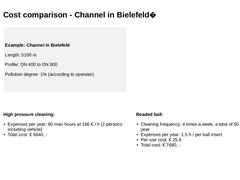
|
Example: Channel in Bielefeld Length: 5100 m Profile: DN 400 to DN 800 Pollution degree: 1% (according to operator) |
High pressure cleaning: - Expenses per year: 80 man hours at 166 € / h [2 persons including vehicle]
- Total cost: € 6640, -
Beaded ball: - Cleaning frequency: 4 times a week, a total of 50 weeks per year
- Expenses per year: 1.5 h / per ball insert
- Per-use cost: € 25.6
- Total cost: € 7680, -
|

|
|
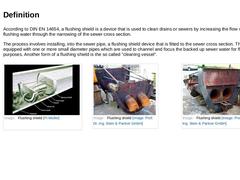
|
According to DIN EN 14654, a flushing shield is a device that is used to clean drains or sewers by increasing the flow velocity of the flushing water through the narrowing of the sewer cross section. The process involves installing, into the sewer pipe, a flushing shield device that is fitted to the sewer cross section. The shield is equipped with one or more small diameter pipes which are used to channel and focus the backed up sewer water for flushing … |
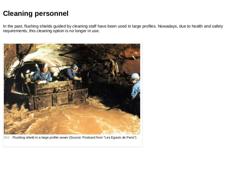
|
In the past, flushing shields guided by cleaning staff have been used in large profiles. Nowadays, due to health and safety requirements, this cleaning option is no longer in use. (Image: Flushing shield in a large profile sewer (Source: Postcard from "Les Egouts de Paris")) |
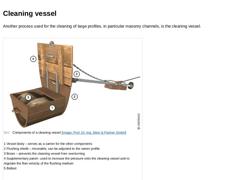
|
Another process used for the cleaning of large profiles, in particular masonry channels, is the cleaning vessel. (Image: Components of a cleaning vessel) |
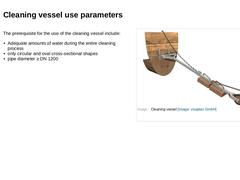
|
The prerequisite for the use of the cleaning vessel include: - Adequate amounts of water during the entire cleaning process
- only circular and oval cross-sectional shapes
- pipe diameter ≥ DN 1200
|
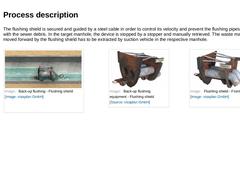
|
The flushing shield is secured and guided by a steel cable in order to control its velocity and prevent the flushing pipes from colliding with the sewer debris. In the target manhole, the device is stopped by a stopper and manually retrieved. The waste material that is moved forward by the flushing shield has to be extracted by suction vehicle in the respective manhole. | (Image: Back-up flushing - Flushing shield) | (Image: Back-up flushing equipment - … |
|
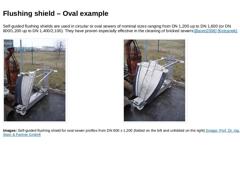
|
Self-guided flushing shields are used in circular or oval sewers of nominal sizes ranging from DN 1,200 up to DN 1,600 (or DN 800/1,200 up to DN 1,400/2,100). They have proven especially effective in the cleaning of bricked sewers [Baren2006] [Kotcanek]. (Image: Self-guided flushing shield for oval sewer profiles (folded position)) (Image: Self-guided flushing shield for oval sewer profiles (open position)) Images: Self-guided flushing shield for oval … |
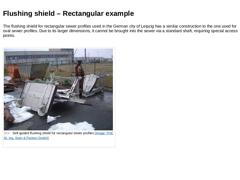
|
The flushing shield for rectangular sewer profiles used in the German city of Leipzig has a similar construction to the one used for oval sewer profiles. Due to its larger dimensions, it cannot be brought into the sewer via a standard shaft, requiring special access points. (Image: Self-guided flushing shield for rectangular sewer profiles) |
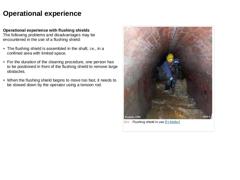
|
Operational experience with flushing shields
The following problems and disadvantages may be encountered in the use of a flushing shield: -
The flushing shield is assembled in the shaft, i.e., in a confined area with limited space.
-
For the duration of the cleaning procedure, one person has to be positioned in front of the flushing shield to remove large obstacles.
-
When the flushing shield begins to move too fast, it needs to be slowed down by the …
|
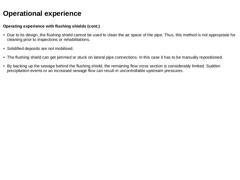
|
Operating experience with flushing shields (cont.) -
Due to its design, the flushing shield cannot be used to clean the air space of the pipe. Thus, this method is not appropriate for cleaning prior to inspections or rehabilitations.
-
Solidified deposits are not mobilised.
-
The flushing shield can get jammed or stuck on lateral pipe connections. In this case it has to be manually repositioned.
-
By backing up the sewage behind the flushing shield, the …
|

|
Operating experience with flushing shields (cont.) -
Generally, a team of 4-5 people is required for the assembly, operation and removal of the flushing shield. The cleaning performance per day strongly depends on the local limiting conditions. It varies between just a few metres in the case of low water levels and large deposit amounts to several hundred metres in the case of favourable water levels and small deposit amounts. The daily performance …
|